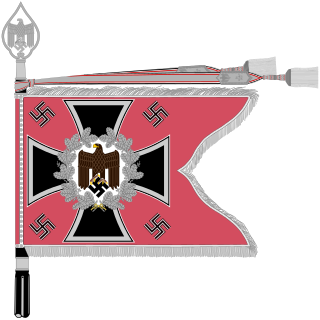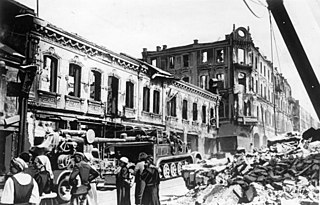
Hermann Hoth was a German army commander, war criminal, and author. He served as a high-ranking panzer commander in the Wehrmacht during World War II, playing a prominent role in the Battle of France and on the Eastern Front. Contemporaries and later historians consider Hoth one of the most talented armoured warfare commanders of the war. He was a strong believer in Nazism, and units under his command committed several war crimes including the murder of prisoners of war and civilians.

Heinrich Eberbach was a German general during World War II who commanded the 5th Panzer Army during the Allied invasion of Normandy. He was a recipient of the Knight's Cross of the Iron Cross with Oak Leaves of Nazi Germany.
The 1st Panzer Army was a German tank army that was a large armoured formation of the Wehrmacht during World War II.

Panzerwaffe, later also Panzertruppe refers to a command within the Heer of the German Wehrmacht, responsible for the affairs of panzer (tank) and motorized forces shortly before and during the Second World War.
The 2nd Panzer Army was a German armoured formation during World War II, formed from the 2nd Panzer Group on October 5, 1941.
As the number of German troops committed to the North African Campaign of World War II grew from the initial commitment of a small corps, the Germans developed a more elaborate command structure and placed the enlarged Afrika Korps, with Italian units under this new Italian and German command and a succession of commands were created to manage Axis forces in Africa:

The 4th Panzer Army, operating as Panzer Group 4 from its formation on 15 February 1941 to 1 January 1942, was a German panzer formation during World War II. As a key armoured component of the Wehrmacht, the army took part in the crucial battles of the German-Soviet war of 1941–45, including Operation Barbarossa, the Battle of Moscow, the Battle of Stalingrad, the Battle of Kursk, and the 1943 Battle of Kiev.
A panzer corps was an armoured corps type in Nazi Germany's Wehrmacht during World War II. The name was introduced in 1941, when the motorised corps were renamed to panzer corps. Panzer corps were created throughout the war, and existed in the Army, the Waffen-SS and even the Luftwaffe. Those renamed from ordinary motorised corps retained their numbering.

The Battle of Białystok–Minsk was a German strategic operation conducted by the Wehrmacht's Army Group Centre under Field Marshal Fedor von Bock during the penetration of the Soviet border region in the opening stage of Operation Barbarossa, lasting from 22 June to 9 July 1941.
The 3rd Panzer Army was a German armoured formation during World War II, formed from the 3rd Panzer Group on 1 January 1942.

Georg-Hans Reinhardt was a German general of the Wehrmacht during World War II, who was subsequently convicted of war crimes. He commanded the 3rd Panzer Army from 1941 to 1944, and Army Group Centre in 1944 and 1945, reaching the rank of colonel general (Generaloberst).

The Manstein Plan or Case Yellow, was the war plan of the German armed forces for the Battle of France in 1940. The original invasion plan was an awkward compromise devised by General Franz Halder, the chief of staff of Oberkommando des Heeres that satisfied no one. Documents with details of the plan fell into Belgian hands during the Mechelen incident on 10 January 1940 and the plan was revised several times, each giving more emphasis to an attack by Army Group A through the Ardennes, which progressively reduced the offensive by Army Group B through the Low Countries to a diversion.

Traugott Herr was a German general during World War II who commanded the 14th Army and the 10th Army of the Wehrmacht. He was a recipient of the Knight's Cross of the Iron Cross with Oak Leaves and Swords.

The 268th Infantry Division was a German Army division active and operating during the Second World War.

Walther von Hünersdorff was a German general during World War II who commanded the 6th Panzer Division. He was a recipient of the Knight's Cross of the Iron Cross with Oak Leaves and was killed during the Battle of Kursk.

The 24th Infantry Division was a German Army infantry division active in World War II. It served across the Eastern Front in engagements such as the Sieges of Sevastopol and the Leningrad, finally being destroyed in the Courland Pocket in 1945.

The 31st Infantry Division was a German infantry division of the Army during World War II. It participated in the invasion of Poland in 1939 then the invasion of France and the Low Countries in 1940. As part of Panzergruppe 2. of Army Group Centre, it was involved in the invasion of the Soviet Union in June 1941. After hard fighting throughout 1941 and 1942 it joined the 9th Army and fought in the Battle of Kursk in July and August 1943. Along with the rest of the 9th Army, the division conducted a fighting withdrawal for the remainder of 1943, during which it sustained heavy casualties. In the early stages of the Soviet Operation Bagration of June to August 1944, the 31st Infantry Division was destroyed, a fate which subsequently befell most of Army Group Centre. The division was officially disbanded on 18 July 1944.
The 5th Guards Zimovnikovskaya order Kutuzov II degree Motor Rifle Division, named on the 60th anniversary of the USSR, was a military formation of the Soviet Ground Forces. It was formed from the 6th Mechanized Corps created in 1940 and destroyed in 1941 in the beginning of Operation Barbarossa. The corps was reformed in November 1942 under the same name, but with a different organizational structure. In January 1943, the 6th Mechanized Corps was granted "Guards" status and became the 5th Guards Mechanized Corps.
The XIX Army Corps was an armored corps of the German Wehrmacht between 1 July 1939 and 16 November 1940, when the unit was renamed Panzer Group 2 and later 2nd Panzer Army. It took part in the Invasion of Poland and the Battle of France.
The XXII (Motorized) Army Corps was a German army corps during World War II.











